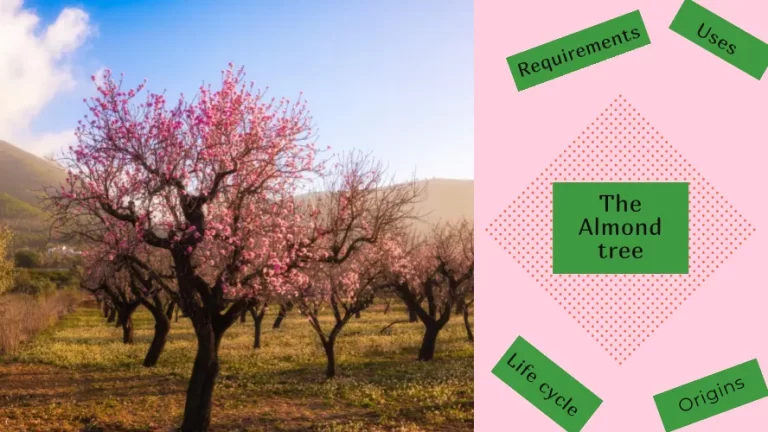The Almond’s Path Through History

Almonds, a food beloved by many, have a very rich history. To the surprise of many, it extends far beyond the nut-filled granolas, almond milk, and gluten-free almond flour commonly found on supermarket shelves.
Almonds have been a staple in human diets, trade routes, and even religious ceremonies, dating back thousands of years.
To fully appreciate the role that almonds played in human diets and cultures for thousands of years, we must journey back in time. We must travel across continents and cultures, and explore archaeological findings and early linguistic traces.
Etymology and Early References
The term “almond” has an intriguing linguistic lineage that reflects its long history and geographical journey. Rooted in the ancient languages of the Eastern Mediterranean, the word “almond” is descended from the Old French “almande,” adapted from the Latin “amygdala,” itself borrowed from the Greek “ἀμυγδάλη” (amygdálē). Each iteration carries a reference to an almond, revealing the nut’s pervasive presence in these cultures.
Interestingly, the term “amygdala” also refers to a region of the brain. It was named after its almond-like shape, demonstrating the nut’s influence even in neuroscience.
Almonds in early texts and mythologies
As for early mentions of almonds, their references in historical documents are as widespread as their cultivation. The earliest literary nod to almonds can be found in the Bible, where they symbolize divine approval and watchfulness. Aaron’s rod, which budded, flowered, and produced almonds overnight, is a prime example of the nut’s spiritual significance in ancient texts.
Further east, in Greek mythology, the almond tree held a position of symbolic importance. The story goes that Phyllis, left by her husband Demophon, died of heartbreak and was transformed into an almond tree. Upon Demophon’s return, he embraced the barren, leafless tree, which instantly burst into bloom, a testament to undying love and hope. This poignant tale underlines the almond’s enduring presence in early mythologies.
Almonds in Archaeological Discoveries
Almonds have left a trail of crumbs for archaeologists to follow. This trail, leading to significant archaeological findings, allows us to piece together their journey throughout history. It offers a glimpse into almonds’ prominent role in different societies and how they’ve been treasured over millennia.
Numeira: echoes of almonds in the early bronze age
An important archaeological site that sheds light on almond history is Numeira, located in present-day Jordan. It’s the oldest known place that shows signs of almond tree domestication. Excavations have revealed evidence of domesticated almonds at that spot, dating back to the Early Bronze Age (around 3500-2000 BC in this region).
These findings suggest that humans had not only begun consuming almonds but had also embarked on a journey of cultivating and domesticating them. That signified the dawn of agricultural advancements.
Almonds in the tomb of Tutankhamun
Almonds have also made an appearance in some of the most sacred and monumental settings. When King Tutankhamun’s tomb was opened in Egypt, almonds were among the treasures. These almonds originated from approximately 1325 BC and were likely imported from the Levant. This discovery highlights the value and desirability of almonds across different societies.
These discoveries underscore the extensive history of almonds, a narrative steeped in culture and shaped by global influences. From Bronze Age settlements to royal tombs, the almond has left an indelible mark on our shared past.
The Domestication of Almonds
The transition of almonds from wild to cultivated varieties is a fascinating chapter in agricultural history. As we mentioned, this event is believed to have happened during the Early Bronze Age.
The appeal of almonds to early growers originated from their ability to propagate from seeds. That was an advantageous trait during an era devoid of advanced farming tools and techniques. Almond trees, therefore, are believed to be among the first domesticated trees.
This transformation went from deadly to delightful
Interestingly, the domestication process also altered the nature of the almonds themselves. Prior to domestication, bitter almond varieties were prevalent. These almonds contained cyanide, making them potentially deadly. Ancient societies discovered methods to neutralize this toxicity by leaching or roasting.
The domestication process, however, led to the emergence of a sweet variety of almonds, free from the cyanide toxicity of their bitter counterparts. Domesticating almonds marked a shift from survival-focused food processing to the cultivation of taste and dietary preference.
Almonds Reached Other Continents in Ancient Times
The journey of almonds did not stop in the Middle East. Over time, they infiltrated the food cultures of societies far and wide. The intricate trade networks of the ancient world were responsible for that, notably the Silk Road.

This sprawling trade route facilitated the exchange of goods and ideas across the Mediterranean, Asia, and Northern Africa. This route allowed almonds to make their mark on diverse areas of the known world.
Greece quickly adopted almonds
Around the 4th century BC, Alexander the Great’s armies transported almonds to Greece. In ancient Greece, almond trees were revered. Besides being part of their diets, almonds were often used in Greek mythology and arts.
The almond’s journey to Rome
The almond’s voyage continued to ancient Rome, where its popularity grew and its cultivation expanded. In Rome, almonds had diverse uses, and their cultivation was valued for the nut and also for the oil extracted from it. The Romans considered almond oil versatile and valuable. They used it in cosmetics, medicines, and even as a base for fragrances.
The Romans spread almonds throughout Europe
As Rome expanded, it carried its cherished agricultural products, including almonds. Roman garrisons stationed in the far reaches of the empire used almonds as a portable source of nutrition. That led to the introduction of almonds in places like Britain and Gaul (modern-day France). It marked the beginning of almond cultivation in these regions.
Almonds also traveled south, finding a new home in Africa, particularly in northern parts such as Morocco and Tunisia. The warm Mediterranean climate of these regions favored almond growth, leading to their incorporation into local cuisines.
Almonds in The Middle Ages
The popularity of almonds had a little break after ancient times. However, they found their way into the spotlight again during the Middle Ages, this time in liquid form. Almond milk became a dietary mainstay and represented a gastronomic innovation and adherence to religious observances of the era.
A luxurious dairy substitute
During this period, almond milk was more than a dietary staple. It was considered a luxurious beverage enjoyed mainly by the elite class. What led to its rise in popularity was a unique combination of religious devotion and culinary innovation. Christian Europe had strict dietary restrictions that prohibited the consumption of animal products on certain days of the week.

Almond milk emerged as a clever and delicious substitute in the absence of traditional dairy. This plant-based milk offered a way to adhere to religious mandates without compromising taste or nutritional value.
Making its mark in culinary literature
Almond milk’s popularity during this time wasn’t limited to consumption as a standalone beverage. It was widely used as a dairy alternative in many recipes, which enriched the culinary landscape with its unique flavor and texture. It influenced culinary practices to such an extent that it featured prominently in the cookbooks of the era.
Almonds’ Arrival in The Americas
The next significant milestone in the almonds’ journey came with their arrival in the Americas. Spanish missionaries and explorers introduced almonds to the New World during the 16th and 17th centuries. However, it wasn’t until the mid-18th century that almonds made their mark in what is now the United States.
Franciscan monks are credited with planting the first almond trees in California, taking advantage of the state’s Mediterranean-like climate. However, California’s commercial almond industry only took off in the 19th century. By this time, improved irrigation techniques and transcontinental railroads made large-scale almond farming viable. Today, California is a dominant force in global almond production.
Bridging the Past and Future of Almonds
From the wild nut of ancient times to the sweet food source of today, the journey of almonds is intriguing and inspiring. They’ve traced an extraordinary path through human history.
They spread across trade routes, took root in distant lands, and have stood the test of time, remaining significant through the ages. A proof of that is that, around the world, traditional festivals and rituals still celebrate almonds.
As we look forward, the almond’s significance only seems to grow. Its integration into our diets, wellness industry, and cultural practices is deepening. We eagerly anticipate the new chapters unfolding in the almond’s enduring story.





